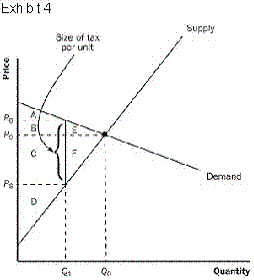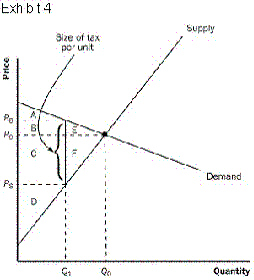True/False
Indicate whether the
statement is true or false.
|
|
|
1.
|
In general, a tax raises the price the buyers pay, lowers the price the sellers
receive, and reduces the quantity sold.
|
|
|
2.
|
If a tax is placed on a good and it reduces the quantity sold, there must be a
deadweight loss from the tax.
|
|
|
3.
|
Deadweight loss is the reduction in consumer surplus that results from a
tax.
|
|
|
4.
|
When a tax is placed on a good, the revenue the government collects is exactly
equal to the loss of consumer and producer surplus from the tax.
|
|
|
5.
|
If Stefan values having his hair cut at €20 and Magda’s cost of
providing the hair cut is €10, any tax on hair cuts larger than €10 will eliminate the
gains from trade and cause a €20 loss of total surplus.
|
|
|
6.
|
If a tax is placed on a good in a market where supply is perfectly inelastic,
there is no deadweight loss and the sellers bear the entire burden of the tax.
|
|
|
7.
|
A tax on cigarettes would likely generate a larger deadweight loss than a tax on
luxury boats.
|
|
|
8.
|
A tax will generate a greater deadweight loss if supply and demand are
inelastic.
|
|
|
9.
|
A tax causes a deadweight loss because it eliminates some of the potential gains
from trade.
|
|
|
10.
|
A larger tax always generates more tax revenue.
|
|
|
11.
|
A larger tax always generates a larger deadweight loss.
|
|
|
12.
|
If an income tax rate is high enough, a reduction in the tax rate could increase
tax revenue.
|
|
|
13.
|
A tax collected from buyers generates a smaller deadweight loss than a tax
collected from sellers.
|
|
|
14.
|
If a tax is doubled, the deadweight loss from the tax more than doubles.
|
|
|
15.
|
A deadweight loss results when a tax causes market participants to fail to
produce and consume units on which the benefits to the buyers exceeded the costs to the
sellers.
|
Multiple Choice
Identify the
choice that best completes the statement or answers the question.
|
|
|
16.
|
Refer to Exhibit 4. If there is no tax placed on the product in this market,
consumer surplus is the  a. | Area C + D + F | b. | Area A | c. | Area A + B +
E | d. | Area D + C + B | e. | Area A + B + C |
|
|
|
17.
|
Refer to Exhibit 4. If there is no tax placed on the product in this market,
producer surplus is the  a. | Area A + B + E | b. | Area D | c. | Area C +
F | d. | Area A + B + C + D | e. | Area C + D + F |
|
|
|
18.
|
Refer to Exhibit 4. If a tax is placed on the product in this market, consumer
surplus is the  a. | Area D | b. | Area A | c. | Area A + B +
E | d. | Area A + B + C + D | e. | Area A + B |
|
|
|
19.
|
Refer to Exhibit 4. If a tax is placed on the product in this market, producer
surplus is the  a. | Area A + B + E | b. | Area A + B + C + D | c. | Area
A | d. | Area D | e. | Area C + D + F |
|
|
|
20.
|
Refer to Exhibit 4. If a tax is placed on the product in this market, tax
revenue paid by the buyers is the  a. | Area B + C + E + F | b. | Area B | c. | Area B +
C | d. | Area A | e. | Area C |
|
|
|
21.
|
Refer to Exhibit 4. If a tax is placed on the product in this market, tax
revenue paid by the sellers is the  a. | Area C + F | b. | Area A | c. | Area
B | d. | Area B + C + E + F | e. | Area C |
|
|
|
22.
|
Refer to Exhibit 4. If there is no tax placed on the product in this market,
total surplus is the  a. | Area B + C + E + F | b. | Area E + F | c. | Area A + B + C +
D | d. | Area A + B + C + D + E + F | e. | Area A + D + E +
F |
|
|
|
23.
|
Refer to Exhibit 4. If a tax is placed on the product in this market, total
surplus is the  a. | Area A + B + C + D + E + F | b. | Area A + B + C + D | c. | Area A +
D | d. | Area B + C + E + F | e. | Area E + F |
|
|
|
24.
|
Refer to Exhibit 4. If a tax is placed on the product in this market, deadweight
loss is the  a. | Area B + C + E + F | b. | Area E + F | c. | Area B +
C | d. | Area A + B + C + D | e. | Area A + D |
|
|
|
25.
|
Refer to Exhibit 4. Which of the following is true with regard to the burden of
the tax in Exhibit 4?  a. | The buyers pay a larger portion of the tax because demand is more inelastic than
supply. | b. | The sellers pay a larger portion of the tax because supply is more elastic than
demand. | c. | The buyers pay a larger portion of the tax because demand is more elastic than
supply. | d. | The sellers pay a larger portion of the tax because supply is more inelastic than
demand. |
|
|
|
26.
|
Which of the following would likely cause the greatest deadweight loss?
a. | a tax on salt | c. | a tax on petrol | b. | a tax on cigarettes | d. | a tax on cruise line
tickets |
|
|
|
27.
|
A tax on petrol is likely to
a. | generate a deadweight loss that is unaffected by the time period over which it is
measured. | b. | cause a greater deadweight loss in the long run when compared to the short
run. | c. | not generate any deadweight loss because petrol is a necessity | d. | cause a greater
deadweight loss in the short run when compared to the long run. |
|
|
|
28.
|
Deadweight loss is greatest when
a. | supply is elastic and demand is perfectly inelastic. | b. | demand is elastic
and supply is perfectly inelastic. | c. | both supply and demand are relatively
inelastic. | d. | both supply and demand are relatively elastic. |
|
|
|
29.
|
Since the supply of undeveloped land is relatively inelastic, a tax on
undeveloped land would generate
a. | a small deadweight loss and the burden of the tax would fall on the
renter. | b. | a large deadweight loss and the burden of the tax would fall on the
landlord. | c. | a large deadweight loss and the burden of the tax would fall on the
renter. | d. | a small deadweight loss and the burden of the tax would fall on the
landlord. |
|
|
|
30.
|
Which of the following is true with regard to a tax on labour income? Taxes on
labour income tend to encourage
a. | the unscrupulous to enter the underground economy. | b. | the elderly to
retire early. | c. | all of the things described in these answers. | d. | second earners to
stay home. | e. | workers to work fewer hours. |
|
|
|
31.
|
When a tax on a good starts small and is gradually increased, tax revenue
will
a. | fall. | b. | rise. | c. | first rise and then
fall. | d. | first fall and then rise. | e. | not change at
all |
|
|
|
32.
|
The graph that shows the relationship between the size of a tax and the tax
revenue collected by the government is known as a
a. | Friedman conjecture | b. | Reagan curve. | c. | Keynesian
curve. | d. | Laffer curve. | e. | Chicago school
curve. |
|
|
|
33.
|
If a tax on a good is doubled, the deadweight loss from the tax
a. | doubles. | c. | increases by a factor of four. | b. | stays the
same. | d. | could rise or
fall. |
|
|
|
34.
|
The reduction of a tax
a. | will have no impact on tax revenue. | b. | will always reduce tax revenue regardless of
the prior size of the tax. | c. | could increase tax revenue if the tax had been
extremely high. | d. | causes a market to become less efficient. |
|
|
|
35.
|
When a tax distorts incentives to buyers and sellers so that fewer goods are
produced and sold than otherwise, the tax has
a. | caused a deadweight loss. | c. | generated no tax
revenue. | b. | decreased equity. | d. | increased efficiency. |
|